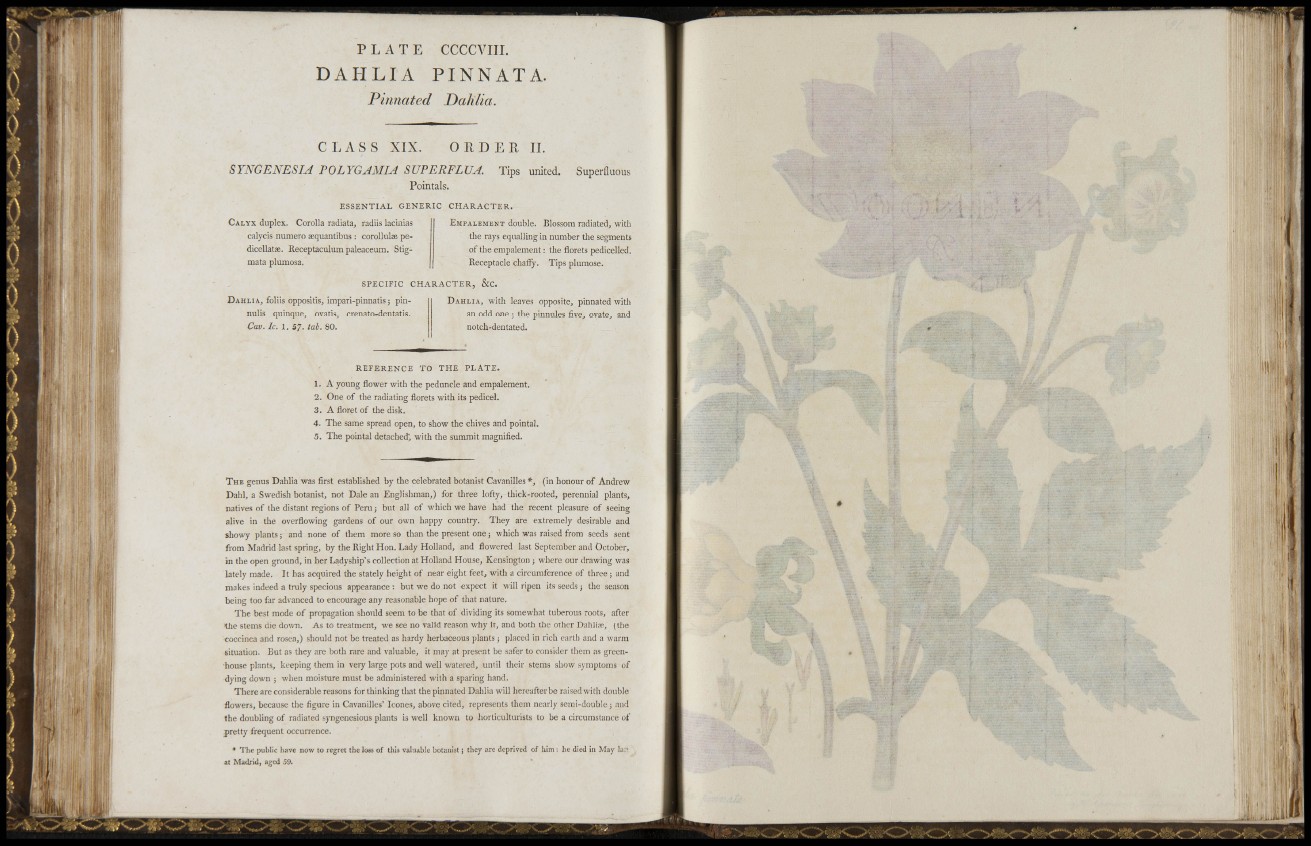
r ^ f t ; ,s II
• U r - 'if
f i ' •(.•Ml liii:!.
h W- i > i i *
p i vi.R'^''' Hif ! *
' I , <
; t
- • -ri» - il IliL., •l'yr
•• . 'Hi'lll
P L x\ T E CCCCVIII.
D A H L I A PINNATA.
Piìinated Dahlia.
C L A S S XIX. ORDER IL
SYNGENESIA POLYGJMIA SUPERFLUA. Tips united. SuperQuous
Pointals.
CALYX duplex. Corolla radiata, radiis lacinias
calycis numero aequantibus : corollulae pedlcellatae.
Receptaculum paleaceum. Stigmata
piumosa.
E S S E N T I A L GENERIC CHARACTER.
EMPALEMENT double. Blossom radiated, with
the rays equalling in number die segments
of the empalement : the florets pedicelled.
Receptacle chaiFy. Tips plumose.
S P E C I F I C CHARACTER, &C.
DAHLIA, foliis oppositis, impari-pinnatis ; pinnulis
quinqué, ovatis, crenato-dentatis.
Cav. Ic. 1. 57. tab. 80.
DAHLIA, with leaves opposite, pinnated with
an odd one ; tlie pinnules five, ovate, and
notcb-dentated.
R E F E R E N C E TO THE PLATE.
1. A young flower with the peduncle and empaleraent.
2. One of the radiating florets with its pedicel.
3. A floret of the disk.
4. The same spread open, to show the chives and pointal.
5. The pointal detached", with the summit magnified.
THE genus Dahlia was first established by the celebrated botanist Cavanilles*, (in honour of Andrew
Dahl, a Swedish botanist, not Dale an Englishman,) for tliree lofty, thick-rooted, perennial plants,
natives of the distant regions of Peru; but all of which we have had the recent pleasure of seeing
alive in the overflowing gardens of our own happy country. They are extremely desirable and
showy plants; and none of them more so than tlie present one; which was raised from seeds sent
from Madrid last spring, by the Right Hon. Lady Holland, and flowered last September and October,
in the open ground, in her Ladyship's collection at Holland House, Kensington ; where our drawing was
lately made. It has acquired the stately height of near eight feet, with a circumference of three ; and
makes indeed a truly specious appearance : but we do not expect it will ripen its seeds; the season
being too far advanced to encourage any reasonable hope of that nature.
The best mode of propagation should seem to be that of dividing its somewhat tuberous roots, after
the stems die down. As to treatment, we see no valid reason why it, and both the other Dabliae, (the
coccinea and rosea,) should not be treated as hardy herbaceous jjlants; placed in rich earth and a warm
situation. But as they are both rare and valuable, it may at present be safer to consider tliem as greenhouse
plants, keeping them in very large pots and well watered, until their stems show symptoms of
dying down ; when moisture must be administered with a sparing hand.
There are considerable reasons for thinking that the pinnated Dahlia will hereafter bo raised with double
flowers, because the figure in Cavanilles' Icones, above cited, represents them nearly semi-double; and
the doubling of radiated syngenesious plants is well known to horticulturists to be a circumstance of
pretty frequent occurrence.
• The public have now to regret the loss of this valuable botanist; they arc deprived of lilm ; he died in May hi:?
at Madrid, aged 59.
i'X
I' iis
I., w
li'f:
il
'I;
J li' il
>'i
il m
li.«,
.iííi
\ 'I,